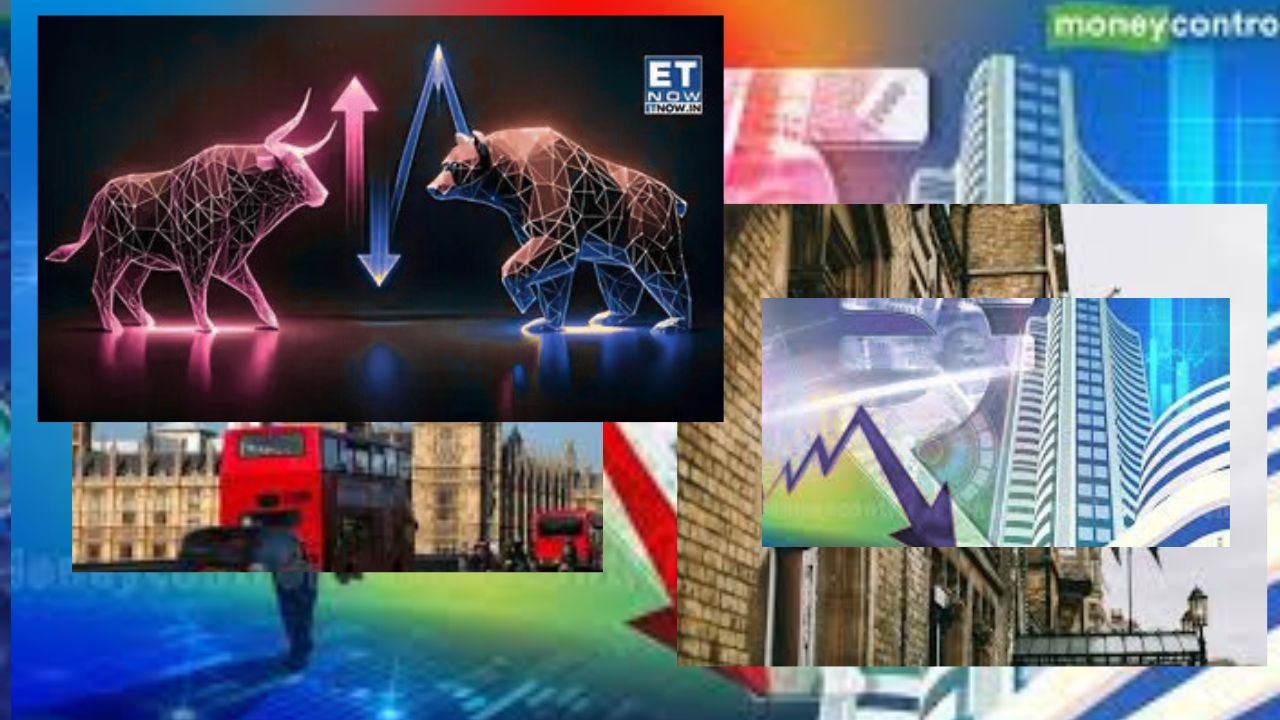The Illusion of Calm: Inside the Brutal Tug-of-War That Left the Nifty Almost Motionless
A close look at a day of stark contradictions, in which IT was both savior and suspect, and the true story wasn't in the index, but in the chaos below.

The Deceptive Stillness of the Beast
Glance at the closing numbers, and you could be inclined to yawn.
The BSE Sensex inched its way up by a paltry 79 points (0.1%). The NSE Nifty managed to add a measly 21 points (0.1%). On the vast canvas of the Indian share market, these are not even brushstrokes; they are pinpricks. It was, on the face of it, a “nothing” day—a day of quiet consolidation, a market catching its breath.
That is an illusion.
To think today was tranquil is to stare a sleeping tiger in the face and fail to see the twitching muscles and tangled tension under the hide. The fact is, today was one of the most intriguing and conflicted trading days we have witnessed in many years. It was a day of primal, visceral combat, a marketplace warring with itself, where strong cross-trends of fear and hope battled to a cruel, draining standstill.
The day opened red, with bears securely in the box. But by the end of the day, the bulls had mounted a gritty, unflashy comeback. It was spearheaded by the very giants of IT and Pharma that tend to presage defensive positioning. And yet, one of the day’s official points of evidence rather curiously indicated selling pressure in the IT sector.
How is that possible?
How can the automobile industry observe “buying” when one of its unchallenged leaders, Tata Motors, featured amongst the day’s leading losers? How can the market be stable when titans like Adani Port and Trent were getting hammered? And what does it imply when the Mid-Cap index climbs while the Small-Cap index declines?
Today we will rip off the tranquil 0.1% veneer and reveal the turbulent, contradictory, and very human drama that played itself out beneath. It is the tale of a two–faced market, and it is the understanding of those divisions that will be the key to steering what lies ahead.
Section 1: The Anatomy of a Grinding Recovery
The day’s story is a tale of two halves. The day started with a tangible feeling of tension. The indices opened down, indicating that the previous day’s bearish sentiment still carried steam. This wasn’t a market leaping out of the starting gates with confidence; this was a market getting up with a headache.
But then, slowly, the tide started to turn. It was not a storming comeback. There was no sudden, exhilarating rush. Rather, it was a gradual, grinding fight. A systematic, inch-by-inch ascent from the depths, spearheaded by two of the market’s most old-fashioned defenders.
The Saviors of the Day: The IT and Pharma Bastions
When uncertainty is the watchword, astute money does not flee but takes cover. On Friday, the cover came in the good old havens of Information Technology and Pharmaceuticals.
The IT Brigade: The likes of Tech Mahindra and HCL Tech were among the top gainers. In a time of geopolitical unpredictability and domestic fear of inflation, these global IT majors symbolise a certain sort of stability. Their top lines are denominated in dollars, offering a buffer against a declining rupee. Their deals are long-term, and their services are integral to the operations of international companies. Their ascent today was a traditional “risk-off” strategy—investors opting for steady, dollar-denominated returns in favor of cycle-driven local tales.
The Pharma Fortress: Likewise, the drug industry offers a defensive moat. Medical expenses are inelastic. Individuals require medicine irrespective of interest levels or economic expansion. A pharma stock rally tends to be a sign that investors are preparing for a bumpy ride and are focusing on the safety of necessary sectors.
The reality that these two spaces spearheaded the rebound says it all about the mood of the market. The bulls didn’t triumph today due to a sudden onset of hope for the Indian economy. They triumphed because investors, to avoid the worse, rotated their capital into these defensive havens of perceived security.
Section 2: The Great Contradiction – A Market at War With Itself
This is where the day’s tale transitions from facile analysis to engaging detective story. The official sectoral statistics provided a set of paradoxes that, at first blush, appear to defy reason. Unraveling them discloses the reality, sophisticated character of today’s market.
The IT Paradox: Savior and Suspect?
The biggest contradiction: IT stocks such as HCL Tech spearheaded the recovery, and yet a report said the “IT sector saw selling pressure.” How is that?
The reason is merciless selectivity. The market is not monolithic. Investors were not “buying IT.” They were buying particular, high-quality, large-cap IT leaders. They were running to the perceived safety of the largest names in the Nifty IT index.
At the same time, they were probably disposing of smaller, weaker mid-cap and small-cap IT firms that are more exposed to a global slowdown or client-related risks. It is a traditional “flight to quality” within a sector. Funds moved out of the riskier segments of the IT universe and into its safest shores. So, while the leaders flew and underpinned the Nifty, the larger sector may well have faced net selling pressure. The market was differentiating with precision of a surgeon.
The Auto Enigma: Buying the Sector, Selling the Leader?
The second enigma: The “auto sector saw buying,” but Tata Motors, a giant of the sector, was one of the top losers.
Once again, the solution is differentiation. The “auto sector” is not Tata Motors. It encompasses:
Two-wheeler (Bajaj Auto, Hero MotoCorp)
Passenger automobile manufacturers (Maruti Suzuki)
Commercial vehicle manufacturers
A huge world of auto ancillary firms
It is quite possible that investors were investing in two-wheeler stocks on rural recovery hopes, or in individual auto component manufacturers who received good news. They might have been selling Tata Motors because of fears over its overseas Jaguar Land Rover (JLR) business, weakening of premium overseas markets, or for company-specific debt.
The market wasn’t buying “autos”; it was making specific, targeted bets within the sector, and today, the bet was against one of its giants.
Section 3: The Market’s Underbelly – A Clear Divide in Risk Appetite
If you really want to know the mood of the market, you need to glance away from the head-line indices and into its deeper layers. The difference between the mid-cap and small-cap indices today was maybe the most truthful indication of them all.
The BSE MidCap Index closed 0.3% higher.
The BSE SmallCap Index closed 0.2% lower.
This is no random movement. This is an unmistakable, unequivocal indication of investor wariness and flight to safety.
Mid-Caps: The So-Called “Sweet Spot”
In a volatile market, established mid-cap firms are usually the “Goldilocks” option. They are big enough to have settled businesses, quality management, and can ride out economic downturns, but still have plenty of room for expansion relative to their large-cap counterparts. The 0.3% rise here indicates that investors were prepared to take some measured gambles, but only in firms with established records of success and healthy balance sheets.
Small-Caps: The First to Be Discarded
On the other hand, small-cap stocks are on the extreme end of the risk category. They are more exposed to recessions, have limited access to cheap capital, and their business models become more tenuous. The 0.2% decline in this index is a typical symptom of risk aversion. When storm clouds gather, investors always first dispose of their riskiest positions. Today, they did just that.
The tale that these two indices have to tell is straightforward: investors are cautious. They are withdrawing funds from the most speculative parts of the market and investing them in bigger, more secure, more established firms.
Section 4: The Silent Witnesses – The Rupee and the Future
Two remaining data points give us essential background, serving as the stage to the day’s drama.
1. The Rupee’s Silent Warning (Trading at 87.7 vs. the US$)
A weakening rupee is a double-edged sword. While it helps exporters such as the IT majors, it’s a cause of underlying stress for the overall economy. It raises the cost of imports, particularly vital commodities such as oil, which feeds inflation. It also makes it more costly for Indian businesses to refinance foreign-currency debt. A rupee at this level is a chronic, low-grade fever for the economy, a reminder of the macroeconomic tensions at work.
2. The GIFT Nifty’s Glimmer of Hope (Up 65 points)
Whereas the home market was struggling to a draw, the GIFT Nifty in Singapore was presenting a brighter picture for the next trading session. Trading 65 points higher, it indicates that futures players, peering into the future, were placing their bets on an upstart opening. This may be on account of overnight news in overseas markets or on an expectation that the recovery at home has further mileage.
This contrast is ideal: the present reality is taint of a weak rupee, but the near future dangles a ray of hope. It is ideal in capturing the divided mind of the market today.
Conclusion: A Mandate for the Discerning Investor
Thus, what is the last lesson from this day of false tranquility?
0.1% was a fabrication. It was an statistical anomaly, the outcome of a brutal tug-of-war between strong forces that fought to a draw. Today was a tale of deep division:
Defensive sectors and Cyclical sectors.
Large-cap leaders and The rest of the sector pack.
Established mid-caps and Speculative small-caps.
This is the definition of a stock-picker’s market. The era of blindly purchasing the index and riding a tide of widespread euphoria is over. The market is no longer monolithic; it is a million different stories and a sophisticated ecosystem, and it is rewarding and punishing companies on their own merits with ruthless efficiency.
The call to investors is explicit. It is a time for thorough research, a time to distinguish between a sector and its leaders, and a time to know that in a warring market, safety can be found only in quality.
(Disclaimer: This article is for informational and educational purposes only. It does not constitute financial advice or a recommendation to buy or sell any securities. Please consult with a qualified financial advisor before making any investment decisions.)





